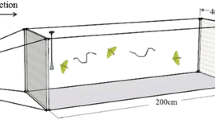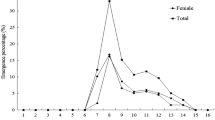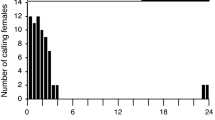Abstract
Reproduction of female Varroa destructor happens within the sealed brood cell of the honeybee host. The mating represents the last step of the reproductive cycle and is usually performed between the mature male offspring and one or more daughter mites. By offering solvent extracts of freshly molted females to male Varroa mites in our mating bioassay, we could clearly confirm the presence of a volatile female sex pheromone. After separation of the extract into a polar and non-polar fraction, only the polar fraction elicited the typical mating behavior of male mites. GC-MS analysis of the active fraction revealed a pattern of three fatty acids as the main components and the respective ethyl esters. We could prove that all these substances stimulated the male mating behavior, and we present results on the dose-dependent reactions of the males toward these compounds. The identification of a Varroa sex pheromone might enable new options for a biological control of the parasite.




Similar content being viewed by others
References
Allan, S.A., Phillips, J.S., Taylor, D., Sonenshine, D.E. (1988) Genital sex pheromones of ixodid ticks: evidence for the role of fatty acids from the anterior reproductive tract in mating of Dermacentor variabilis and Dermacentor andersoni. J Insect Physiol 34(4), 315–323
Allan, S.A., Phillips, J.S., Sonenshine, D.E. (1991) Role of genital sex pheromones in Amblyomma americanum and A. maculatum (Acari: Ixodidae). Exp Appl Acarol 11, 9–21
Chiroudi, E., Rosenkranz, P., Aumeier, P. (1997) Altersabhängige und rasenspezifische Duftstoffmuster bei Arbeiterinnen der Honigbiene (A. mellifera). Mittlg. der Ges. Allg Angew Entomol 11, 179–182
Del Piccolo, F., Nazzi, F., Della, V.G., Milani, N. (2010) Selection of Apis mellifera workers by the parasitic mite Varroa destructor using host cuticular hydrocarbons. Parasitology 137, 967–973
Donzé, G., Guerin, P.M. (1994) Behavioral attributes and parental care of Varroa mites parasitizing honeybee brood. Behav Ecol Sociobiol 34, 305–319
Donzé, G., Herrmann, M., Bachofen, B., Guerin, P.M. (1996) Effect of mating frequency and brood cell infestation rate on the reproductive success of the honeybee parasite Varroa jacobsoni. Ecol Entomol 21, 17–26
Garrido C. (2004) Reproduktionssteuerung bei der parasitischen Bienenmilbe Varroa destructor Anderson & Trueman (ehemals Varroa jacobsoni). Ph.D. Thesis at the Faculty of Biology at the University of Hohenheim, 82 pp.
Garrido, C., Rosenkranz, P. (2004) Volatiles of the honey bee larva initiate oogenesis in the parasitic mite Varroa destructor. Chemoecology 14, 193–197
Kraus, B. (1993) Preferences of Varroa jacobsoni for honey bees Apis mellifera L. of different ages. J Apic Res 32, 57–64
Kuenen, L.P.S., Calderone, N.W. (1997) Transfers of Varroa mites from newly emerged bee: preferences for age- and function-specific adult bees. J Insect Behav 10, 213–228
Le Conte, Y., Arnold, G. (1988) Etude du thermopreferendum de Varroa jacobsoni Oud. Apidologie 19, 155–164
Le Conte, Y., Arnold, G., Troullier, J., Masson, C., Chappe, B., Ourisson, G. (1989) Attraction of the parasitic mite Varroa to the drone larvae of honeybees by simple aliphatic esters. Science 245, 638–639
Le Conte, Y., Arnold, G., Troullier, J., Masson, C., Chappe, B. (1990) Identification of a brood pheromone in honeybees. Naturwissenschaften 77, 334–336
Le Conte, Y., Streng, L., Troullier, J. (1994) The recognition of larvae by worker honeybees. Naturwissenschaften 81, 462–465
Le Conte, Y., Mohammedi, A., Robinson, G.E. (2001) Primer effects of a brood pheromone on honeybee behavioural development. Proc R Soc London B 268, 163–168
Lindenmayer A. (2007) Chemotaktische Orientierung bei der Partnerfindung und Details des Kopulationsverhaltens der Bienenmilbe Varroa destructor, State Examination for Secondary School Teaching Qualification, Dept. of Biology, University of Tübingen.
Martin, C., Provost, E., Bagnères, A.G., Roux, M., Clèment, J.L., Le Conte, Y. (2002) Potential mechanism for detection by Apis mellifera of the parasitic mite Varroa destructor inside sealed brood cells. Physiol Entomol 27, 175–188
Milani, N., Chiesa, F. (1990) Some factors affecting the reproduction of Varroa jacobsoni Oud. under laboratory conditions. Apicoltura 6, 33–42
Nation, J.L., Sanford, M.T., Milne, K. (1992) Cuticular hydrocarbons from Varroa jacobsoni. Exp Appl Acarol 16, 331–344
Nazzi, F., Milani, N., Della, V.G. (2004) A semiochemical from larval food influences the entrance of Varroa destructor into brood cells. Apidologie 35, 403–410
Nazzi, F., Bortolomeazzi, R., Della, V.G., Del Piccolo, F., Annoscia, D., Milani, N. (2009) Octanoic acid confers to royal jelly Varroa-repellent properties. Naturwissenschaften 96, 309–314
Rickli, M., Guerin, P.M., Diehl, P.A. (1992) Palmitic acid released from honeybee worker larvae attracts the parasitic mite Varroa jacobsoni on a servosphere. Naturwissenschaften 79, 320–322
Rosenkranz, P. (1988) Temperaturpräferenz der Varroa-Milbe und Stocktemperaturen an Tropenstandorten. Entomol Gen 14, 123–132
Rosenkranz, P., Aumeier, P., Ziegelmann, B. (2010) Biology and control of Varroa destructor. J Invertebr Pathol 103, 96–119
Schulz, S., Fuhlendorff, J., Steidle, J.L.M., Collatz, J., Franz, J.-T. (2004) Identification and biosynthesis of an aggregation pheromone of the storage mite Chortoglyphus arcuatus. ChemBioChem 5, 1500–1507
Sonenshine, D.E. (2004) Pheromones and other semiochemicals of ticks and their use in tick control. Parasitology 129, 405–425
Stanley-Samuelson, D.W., Jurenka, R.A., Cripps, C., Blomquist, G.J., De Renobales, M. (1988) Fatty acids in insects: composition, metabolism, and biological significance. Arch. Insect Biochem. Physiol. 9(1), 1–33
Troullier, J., Arnold, G., Le Conte, Y., Masson, C., Chappe, B. (1991) Temporal pheromonal and kairomonal secretion in the brood of honeybees. Naturwissenschaften 78, 368–370
Troullier, J., Arnold, G., Chappe, B., Le Conte, Y., Masson, C. (1992) Semiochemical basis of infestation of honey bee brood by Varroa jacobsoni. J Chem Ecol 18(11), 2041–2053
Troullier, J., Milani, N. (1999) Stimulation of Varroa jacobsoni Oud. oviposition with semiochemicals from honeybee brood. Apidologie 30, 3–12
Witzgall, P., Stelinski, L., Gut, L., Thomson, D. (2008) Codling moth management and chemical ecology. Annu Rev Entomol 53, 503–522
Wyatt, T.D. (1997) Putting pheromones to work: paths forward for direct control. In: Cardé, R.T., Minks, A.K. (eds.) Pheromone Research: New Directions, pp. 445–459. Chapman & Hall, New York
Wyatt, T.D. (2003) Pheromones and Animal Behavior: Communication by Smell and Taste. Cambridge University Press, Cambridge
Ziegelmann, B., Lindenmayer, A., Steidle, J., Rosenkranz, P. (2012) The mating behavior of Varroa destructor is triggered by a female sex pheromone, Part 1: Preference behavior of male mites in a laboratory bioassay. Apidologie. doi:10.1007/s13592-012-0182-5
Acknowledgments
We thank the Montagu Foundation and the Agroscope Liebefeld-Posieux for providing financial support. Dipl. Eng. Chem. Thomas Blum from the Department of Applied Chemistry of the University of Reutlingen performed the quantitative analysis. We are very grateful for his qualified support.
Author information
Authors and Affiliations
Corresponding author
Additional information
Manuscript editor: Yves Le Conte
Le comportement d’accouplement de Varroa destructor est déclenché par une phéromone sexuelle de la femelle. Partie 2: Identification des composants de la phéromone sexuelle de Varroa et leurs effets en fonction de la dose
Acari / Varroa destructor / comportement d’accouplement / pheromone sexuelle / Apidae
Das Paarungsverhalten von Varroa destructor wird durch ein weibliches Sexualpheromon gesteuert. Teil 2: Identifizierung und dosisabhängige Effekte von Komponenten des Varroa Sexualpheromons
Varroa destructor / Paarungsverhalten / Sexualpheromon
Rights and permissions
About this article
Cite this article
Ziegelmann, B., Tolasch, T., Steidle, J.L.M. et al. The mating behavior of Varroa destructor is triggered by a female sex pheromone. Part 2: Identification and dose-dependent effects of components of the Varroa sex pheromone. Apidologie 44, 481–490 (2013). https://doi.org/10.1007/s13592-013-0198-5
Received:
Revised:
Accepted:
Published:
Issue Date:
DOI: https://doi.org/10.1007/s13592-013-0198-5




